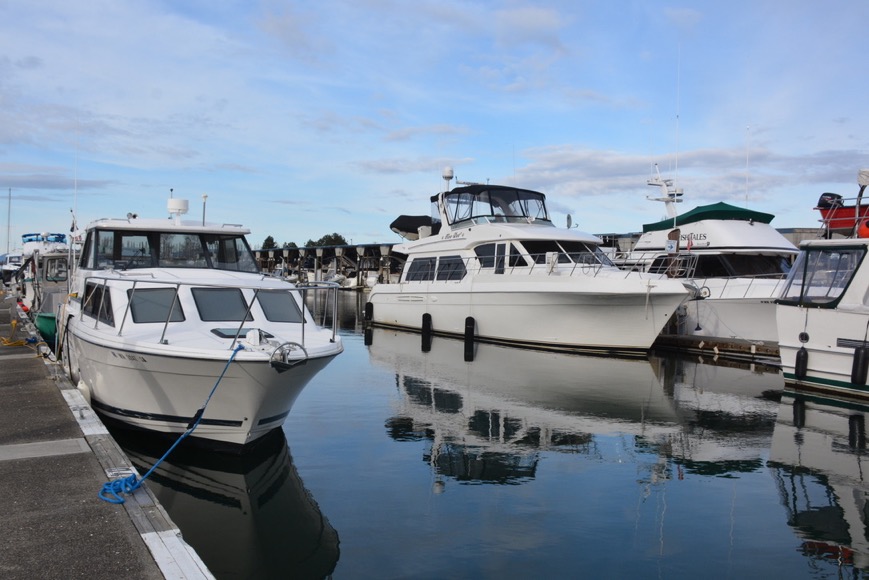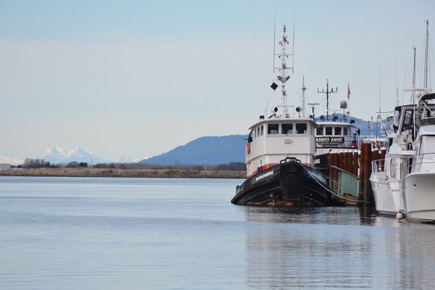Looking at the boats
09/03/21 02:57

Yesterday was a beautiful spring day here in the Pacific Northwest. The sky cleared up, it was warm and sunny - shirtsleeve weather. The trees are just starting to bud out and flowering trees are showing color. The crocuses are blooming and the tulips are a few inches out of the ground. We decided to take a short drive through the tulip and daffodil fields to the nearby town of La Conner. Located on the Swinomish Channel, the downtown area has a waterfront that is home to a small fleet of working fishing vessels and hundreds of recreational boats. The town is directly across the channel from the Swinomish Indian Reservation. The two areas are connected by a beautiful arched bridge, set between two high hills to allow ships with tall masts to pass underneath. There is about a half mile of boardwalk along the channel on the La Conner side of the channel. It is a good place to have a look at the boats and get a sense of the nautical life in a very protected place with good access to the Salish Sea and the nearby San Juan Islands.

We have met a minister who serves in another coastal town who has a primary residence in Seattle, but has a live aboard trawler in a slip in the town where she serves as a second residence.
I’m familiar with having more than one property. When I was about six years old, my parents purchased a run-down auto court with several rough cabins by the river at the edge of town. After my father died, my mother built a lovely two-bedroom log cabin on the property, but when we were kids, it was a group of old cabins that provided some shelter, but weren’t really up to winter living. We camped at the place in the summer, cooking outside at a fire pit and using a shared shower house. That meant that our parents had two places to watch and keep maintained. Over the years, we fixed up some of the buildings at the river place and I learned a lot about replacing window glass, painting and shingling roofs in the process.
Knowing how much work and expense a second home can be, I have never aspired to own one. We have been fortunate to have a camping trailer that we purchased used after our children were grown. It is our version of a vacation property. We can pull it to campgrounds all around the country and have a place to cook our meals and sleep in comfort. We’ve camped all across the west and towed our camper over mountain passes and through beautiful country.
A boat, however, would be an entirely different kind of living space. It requires a whole set of skills for navigating open water, learning about tides and currents and docking procedures. I’m a big fan of boats and own several canoes and kayaks. Some I have purchased. Others I have made. I also have a small row boat that I made a few years ago. I understand the lure of a craft that can navigate the waters. I’m sure I’ll have a kayak in the Swinomish Channel this summer from time to time. I’ll also row and paddle in area lakes and probably take a few paddles on the Skagit River. There are lots of interesting places to explore in our new home.
I am not, however, attracted to the large boats that we see. Having to maintain a vessel that is in the water full time and has to be hauled out for bottom paint and inspection is a whole new level of adventure and expense. I don’t know what it costs to rent a slip in a protected harbor, but I suspect it is substantial. My first boat was a canoe that I built from scratch because I didn’t want to pay the price of a factory-made canoe. I later owned a small sailboat that was on the trash pile at a local boatyard. I salvaged the hull and made fiberglass repairs and paint, adding a bit more weight than the original design. I salvaged a mast and and old sail from another boat that had reached the end of its career and was able to learn a bit of sailing without spending too much money. I think I almost broke even with that boat when I sold it. My most expensive boat in terms of money spent, it a whitewater canoe that was purchased with part of an honorarium I received from performing a wedding. I usually didn’t spend honoraria on myself, but this was an unusual wedding performed when I was on vacation from my usual work and I was really attracted to the boat at the time.
The joke among my canoe and kayak buddies is that the perfect number of boats to own is a matter of a simple mathematical formula. The correct number of boats for an enthusiast is n + 1. In that formula, n = the number of boats you currently own. Boating enthusiasts often seem to want just one more. Randy Cadenhead wrote, “All boats new and old large or small cost the same - one dollar more than you have.” If you put that together with the formula you come up with the definition of a boat: “a hole in the water that you fill up with money.”
I’m happy to leave the expensive boats to other owners. In fact, I’m resolved to keeping my fleet from growing. That means I need to sell or give away one of my kayaks this year when I finish the one I’m building. I think that at my age the formula has become “n - 1.” I’m resolved to spending more time paddling and less time working on boats. That definitely favors fewer boats and definitely puts me out of the market for a bigger boat.
Still, I like walking alongside the channel and looking at the boats.
